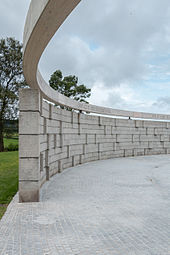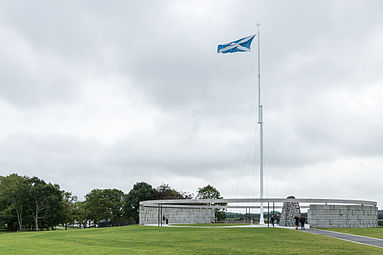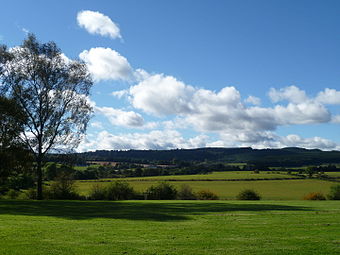Battle of Bannockburn

Depiction of the Battle of Bannockburn from the Holkham Bible , 1327-35 (top, the lower half shows the Battle of Berwick 1318)
| date | 23. bis 24. June 1314 |
|---|---|
| place | Bannockburn near Stirling |
| output | decisive victory for the Scots |
| Parties to the conflict | |
|---|---|
| Commander | |
| Troop strength | |
| 5,000-10,000 men | 13,700-25,000 men |
| losses | |
|
400-4,000 men |
700 cavalrymen, 4,000–11,000 infantrymen |
Battles of the First Scottish War of Independence
Berwick - Dunbar - Stirling Bridge - Falkirk - Roslin - Stirling Castle - Methven - Dalry - Glen Trool - Loudoun Hill - Inverurie - Brander - Perth - Bannockburn - Berwick - Berwick - Myton - Byland - Weardale
Battles of the Second Scottish Revolutionary War
Kinghorn - Dupplin Moor - Annan - Berwick - Halidon Hill - Boroughmuir - Culblean - Neville's Cross
The Battle of Bannockburn on June 23 and 24, 1314 was one of the decisive battles in the Scottish Wars of Independence of the late 13th and 14th centuries. In the marshland of Bannockburn near Stirling , the Scottish army under the leadership of Robert (the) Bruce won a decisive victory against a considerably larger English army under Edward II.
prehistory
In spring 1314, Stirling Castle , which had been under English rule since 1304, was besieged by a Scottish army . When the situation seemed hopeless for the English occupation, the commander Sir Philip Mowbray decided to hand over the strategically important fortress to the Scottish commander, if no English relief army would arrive by the end of June . The English King Edward II now saw an opportunity to place the Scottish army in a decisive battle for the besieged castle. He had succeeded in making a peace with the English aristocratic opposition, the Lords Ordainers . So he had his back free for a campaign to relieve Stirling Castle, to which he invited his vassals in May 1314 .
The English Army
Despite the peace with the king, a number of barons, including four of the nine English earls , stayed away from the campaign. Most noticeable was the absence of Thomas of Lancaster, 2nd Earl of Lancaster , who was among the leaders of the Lords Ordainers, as well as the Earl of Warwick and the Earl of Arundel . On the other hand, Aymer de Valence, 2nd Earl of Pembroke , Gilbert de Clare, 7th Earl of Gloucester and Humphrey de Bohun, 4th Earl of Hereford , all three of whom had also belonged to the Lords Ordainers, took part in the campaign. The exact size of the English army is not known. The king had requested 20,000 foot soldiers, but it is unclear whether that number was actually reached. The accounts of the salary payments have not been received, presumably they were never created because of the hasty flight after the defeat. Still, despite the absence of Lancaster and the other magnates, the army was one of the largest armies raised during the reign of Edward II. The army included not only English contingents, but also Welsh troops, including 2263 infantrymen under John Charlton , and probably also Irish troops and soldiers from Gascony, which was then part of England, and a small number of foreign mercenaries. The English army that had gathered at Berwick-upon-Tweed outnumbered the Scots by far. On June 17 or 18, 1314, it crossed the border at Coldstream and then turned to Stirling. On Sunday, June 23, 1314, the English armed forces had reached the ford at Bannockburn a few kilometers south of Stirling, where the Scottish army had taken up position under the command of Robert Bruce.
The Scottish Army
The Scottish army was about 5,000 men strong. Like King Edward II, Robert the Bruce was not undisputed as a king. He was considered a murderous usurper by many Scots because of the murder of John Comyn . Comyn's son John fought on the English side, as did the Earl of Angus , who as Lord of Prudhoe and Redesdale also had possessions in northern England. In contrast, the MacDonalds of Islay clan under Angus Og had joined the Scottish army despite a clan dispute with Robert the Bruce. In total, the members of 21 clans fought in the Scottish army. Trusting the Scottish Schiltron line-up, the Scottish soldiers intended to fight at close range in order to reduce the superiority of the English heavy cavalry. The thesis that Robert Bruce was on the side of Knights of the Templars who had fled France to seek protection in Scotland is extremely controversial .
The battle
The battle itself took place in an area a few kilometers wide between the Bannock Burn and Forth rivers . It lasted two days, and although the first clashes were rather insignificant compared to the meeting of the two armies on the second day, there was much to be said for a positive outcome of the battle for the Scots due to the strategically extremely unfavorable position of the English armed forces. which were extremely limited in their maneuverability in the swampy area between the two rivers Bannock and Pelstream and the banks of the River Forth.
First day (June 23)
First the English sent a mounted force under Sir Robert de Clifford and Sir Henry de Beaumont to the besieged castle. They encountered a small part of the Scottish infantry force. The Scottish Schiltrons proved themselves again and the English attacks were repulsed with minor losses, so that the English cavalry was forced to retreat. At the same time, there were a number of minor skirmishes around the nuclear force when some English soldiers crossed the Bannock to face the Scottish troops. The fight between the English knight Henry de Bohun (a nephew of the Earl of Hereford) and Robert the Bruce has been handed down: De Bohun had spotted Bruce on a pony in front of the Scottish battle line, put on his lance and rode towards the individual fighter. At the last moment the pony dodged the oncoming warhorse, and Bruce managed to strike De Bohun's helmet with his battle ax and split his skull in two. When, after a few more insignificant skirmishes, dusk fell, the English army withdrew to make camp between Bannock and Pelstream.
Demoralized by this defeat, the English spent the night under arms for fear of a Scottish attack. Alexander Seton , a Scottish defector from the English army is said to have informed Robert Bruce about the insecurity of the English. Given the strength of the English army, Bruce wanted to retreat across the Forth first, but then decided to take up the fight. When the English realized at dawn that the Scots had not retreated, the more experienced barons, as well as the young Earl of Gloucester, suggested that the battle should not begin until the next day so that the army, exhausted by the march, could recover. This advice was rejected as cowardice by younger barons, and the king followed their opinion and ordered the attack. Bruce also attacked in turn.
Second day (June 24th)
The English army advanced across the Bannock while the Scottish army waited in schiltrons. The first English cavalry attack was disorderly and costly. The Scots fought on foot , following the example of the Flemings who had defeated the French knights in 1302 at the Battle of Courtrai . The tightly closed Scottish Schiltrons could not be defeated by the English, while the Scottish spearmen attacked and killed the English horses. The Scottish Force then advanced, forcing the cavalry back into the ranks of the English infantry, which were still trying to get to the cavalry across the Bannock.
King Edward II fought bravely personally, but proved to be an incompetent general. He failed to exploit his numerical superiority. He had failed to cover his archers with infantry, and when they tried to intervene in battle and began arrows at the advancing Scottish infantry, they suffered heavy losses from a counterattack by the small Scottish cavalry under Robert Keith . Edward II did not succeed in keeping his barons under control. There was a dispute between the young Earl of Gloucester and the Earl of Hereford over command of the vanguard . The Earl of Gloucester, still offended by the rejection by the king in the morning, is said to have ridden alone in front of his troops on the Scottish line and was killed.
On the narrow battlefield, the English numerical superiority nullified any attempt to rally their own troops while the Scottish forces pushed the crowds back towards the river. Hundreds of English drowned or were trampled by their own retreating men as the English order of battle broke up. Edward II was led off the battlefield in good time by Henry de Beaumont and, when he was denied entry to Stirling Castle, fled via Winchburgh to Dunbar Castle and finally by ship back to England.
losses
The exact number of English casualties cannot be determined, but the battle is considered to be one of the worst defeats an English army has ever suffered on the battlefield. Thousands of English foot soldiers were killed during the escape. The English entourage fell into the hands of the Scots. The most prominent victim was the Earl of Gloucester. He was one of the richest barons in England and was a brother-in-law of Robert the Bruce, who had his body recovered and transferred to England for burial. Other victims included Robert de Clifford, Miles Stapleton, 1st Baron Stapleton , William de Vescy of Kildare , John Comyn, and Edmund Mauley , the Steward of the Household .
Numerous English barons fell into Scottish captivity and were only released again in return for high ransom payments. Among the prisoners were Ralph de Monthermer , the stepfather of the Earl of Gloucester, and the Lord Seal Keeper Roger Northburgh , who was captured along with the royal private seal. The Earl of Hereford fled with the Earl of Angus and his brother Ingram de Umfraville and with Anthony Lucy to Carlisle , where they sought refuge in Bothwell Castle . The commandant of the castle, a native Scotsman named Walter Fitz Gilbert , ran over to the Scots and handed the castle over to his guests.
As a result of the battle, the crew of Stirling Castle also had to surrender to the Scots.
consequences
After this defeat, Edward II, apart from the siege of Berwick in 1319 , did not undertake a major campaign to Scotland again until 1322 . In turn, Northern England was an easy target for numerous Scottish raids for years. The Scottish victory did not bring a breakthrough for Robert the Bruce, either domestically or externally. King Edward II still did not recognize him as King of Scotland. The actual independence of Scotland was only the result of the Declaration of Arbroath , written by Scottish nobles in 1320 and addressed to the Pope in Rome . Only under King Edward III. Robert the Bruce was recognized as king in the Agreement of Edinburgh and Northampton in 1328 and the border with Scotland was first defined.
Most English prisoners were released in 1314 or early 1315 after paying their ransom. The Earl of Hereford was exchanged for Elizabeth de Burgh , wife of Robert the Bruce, who had been in English captivity since 1306. The death of the Earl of Hertford, who died childless, led to the division of his vast property among his three sisters. This led to the rise of Hugh le Despenser , who was married to one of them. Despenser began a dispute with his brothers-in-law about the division of the inheritance, which led to the Despenser War in 1321 .
The English military leaders learned their lessons from the defeat of Bannockburn. Her men-at-arms in particular fought on foot from then on. Sir Andrew Harclay , a successful commander against the Scots at the time, had not taken part in the battle himself, but from then on he fought in Schiltrons on the Scottish model. In this way he was victorious against the Earl of Lancaster in 1322 at the Battle of Boroughbridge . Similarly, Sir Henry de Beaumont fought with his small Anglo-Scottish army against the Scots in 1322 at the Battle of Dupplin Moor , in which he won an overwhelming victory. Many veterans of the battle attended the English victory of Halidon Hill in 1333 when the English King Edward III. defeated the Scots. These experiences led to the British victories over France in the first phase of the Hundred Years War .
The equestrian statue of Robert the Bruce by Pilkington Jackson
Today the Scots, especially the Scottish National Party , commemorate the battle annually with a march from Stirling city center to the field of Bannockburn, where a wreath is laid at the statue of Robert Bruce at the Bannockburn Rotunda Memorial . The unofficial Scottish national anthem The Flower of Scotland makes reference to the battle. The battle of Bannockburn is mentioned in the final scene of the movie Braveheart .
literature
- Eric Niderost: Red Lion Rampant. In: Military History. Vol. 9, No. 5, 1992, pp. 34-41.
- Kelly DeVries, Martin Dougherty, Iain Dickie: The Great Battles of the Middle Ages. Theiss, Stuttgart 2007, ISBN 978-3-8062-2061-2 .
- Gerald Wolf: For Scotland's freedom . In: Wiener Zeitung from 21./22. June 2014, p. 35.
Web links
- Andy King: The English and the battle of Bannockburn (act. 1314). In: Henry Colin Gray Matthew, Brian Harrison (Eds.): Oxford Dictionary of National Biography , from the earliest times to the year 2000 (ODNB). Oxford University Press, Oxford 2004, ISBN 0-19-861411-X , ( oxforddnb.com license required ), as of 2004
Remarks
- ↑ a b Aryeh Nusbacher : The Battle of Bannockburn 1314. Tempus, Stroud 2002, ISBN 0-7524-2326-6 , p. 85
- ^ Charles Oman: A History of the Art of War in the Middle Ages. Volume 2: 1278-1485 AD. Reprinted edition. Greenhill Books, London 1991, ISBN 1-85367-100-2 , p. 88.
- ↑ Pete Armstrong: Bannockburn 1314. Robert Bruce's great victory (= Campaign 102). Osprey, Oxford et al. 2002, ISBN 1-85532-609-4 , p. 43.
- ↑ a b R. G. Grant: Battle. A Visual Journey Through 5,000 Years of Combat. Revised edition. DK Publishing, New York NY 2009, ISBN 978-0-7566-5578-5 , p. 118.
- ^ A b John Sadler: Scottish Battles. Biddles Ltd., Edinburgh 2010, ISBN 978-1-84341-047-8 , pp. 52-54.
- ^ Peter Reese: Bannockburn. Canongate, Edinburgh 2003, ISBN 1-84195-465-9 , p. 174.









